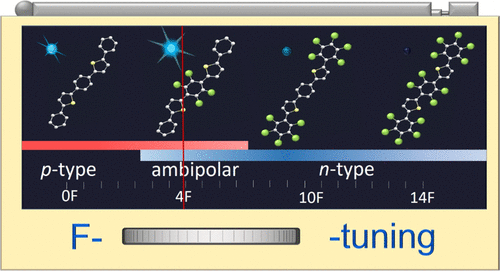Fluorinated Thiophene-Phenylene Co-Oligomers for Optoelectronic Devices
Andrey Yu. Sosorev, Vasiliy A. Trukhanov, Dmitry R. Maslennikov, Oleg V. Borshchev, Roman A. Polyakov, Maxim S. Skorotetcky, Nikolay M. Surin, Maxim S. Kazantsev, Dmitry I. Dominskiy, Viktor A. Tafeenko, Sergey A. Ponomarenko, and Dmitry Yu. Paraschuk.

Organic optoelectronics requires materials combining bright luminescence and efficient ambipolar charge transport. Thiophene-phenylene co-oligomers (TPCOs) are promising highly emissive materials with decent charge-carrier mobility; however, they typically show poor electron injection in devices, which is usually assigned to high energies of their lowest unoccupied molecular orbitals (LUMOs). A widely used approach to lower the frontier orbitals energy levels of a conjugated molecule is its fluorination. In this study, we synthesized three new fluorinated derivatives of one of the most popular TPCOs, 2,2′-(1,4-phenylene)bis[5-phenylthiophene] (PTPTP) and studied them by cyclic voltammetry, absorption, photoluminescence, and Raman spectroscopies. The obtained data reveal a positive effect of fluorination on the optoelectronic properties of PTPTP: LUMO levels are finely tuned, and photoluminescence quantum yield and absorbance are increased. We then grew crystals from fluorinated PTPTPs, resolved their structures, and showed that fluorination dramatically affects the packing motif and facilitates π-stacking. Finally, we fabricated thin-film organic field-effect transistors (OFETs) and demonstrated a strong impact of fluorination on charge injection/transport for both types of charge carriers, namely, electrons and holes. Specifically, balanced ambipolar charge transport and electroluminescence were observed only in the OFET active channel based on the partially fluorinated PTPTP. The obtained results can be extended to other families of conjugated oligomers and highlight the efficiency of fluorination for rational design of organic semiconductors for optoelectronic devices.
